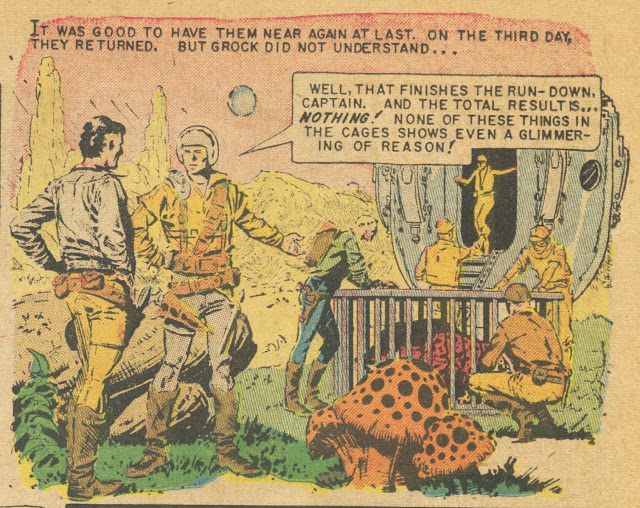Artist Al Williamson put so much effort into drawing this story for EC comics, his pay couldn't have amounted to more than 13 cents per hour.
And that's not even including the backgrounds contributed by his buddy Roy Krenkel "for the fun of it." Williamson later said about his work for EC, "what it shows is that I really loved what I was doing."
At age 23, Williamson wasn't worried about a pension or a mortgage.
Apparently he didn't care about posterity either. All that effort went into comic books, the most fragile medium, which were poorly printed on cheap paper that quickly yellowed and disintegrated.
This was 1955, an era before NFTs and giclée prints. Look at the difference in quality between what Williamson poured into the drawings and what emerged for the public in the finished comic book:
In a society in which everything is for sale, in which deals and auctions make the biggest news, doing it for love is the only remaining liberty.... Do it for love and the rich will envy no one more than you. In a world of tuxedos, the naked man is king. In a world of bookkeepers with spreadsheets, the one who gives it away without counting the cost is God.









15 comments:
Simply awesome quality. Fantastic draftmanship and composition!
Timeless work is done outside the sense of time; in the flow state, when the self disappears, replaced with selflessness.
A heartfelt post David. Thank you.
To love is to know that the act of doing so is simultaneously reciprocated by that that is loved, so much so that which came first is indistinguishable, wherein lies the treasure it has to give, your possession by fulfilment. This is as true for the drawing of a comic strip as it is for painting chapel ceilings. Or beholding a flower.
Thanks for the post - and I forgot about those King Features Flash Gordon , I have those and am digging for them .
One thing about Al , cigarette smoking is a filthy habit ; but no one before or after him made it look more cool or elegant !
Brilliant post.
Decades ago, as much as AW's dexterity in elegant figurework was recognized, it was always connected (appropriately so in many places) to Alex Raymond's influence.
Here you have created an impressive walkthrough of the infinite joy and supreme creativity (Whitman's "procreant urge" in four-color wonder) young Al Williamson evinced through material perhaps very few would have predicted we'd be studying 70 years on, without any obligatory comparisons.
A fine tribute, and a bittersweet meditation on where we are, and definitely aren't.
Thank you David.
Speaking of great artists have you ever done anything on Bernard Krigstein? Saw a YouTube video, Bernard Krigstein: The Most Influential Comic Book Artist and it is quite a story.
It was recently pointed out to me that Dean Cornwell during his premier period (1918-1925) painted full color masterpieces practically week by week - sustaining a level of quality and industry that few if any have ever come close to matching. And every one of those paintings was printed in black and white. So Cornwell was clearly working for another master besides his paymasters.
Kev Ferrara-- I agree totally. Cornwell's control of color was among the very best of 20th century illustrators, and Im astonished that he put that kind of subtlety and sophistication into paintings that would be reproduced in primitive black and white. Similarly, it was amazing that he painted on large stretched canvases when his pictures would be reproduced at a fraction of their size.
You mentioned one the greats of American Illustration, Dean Cornwell. Many of you may be familiar with the Youtube segment of Cornwell painting. The original film is from 1947. It is certainly worth watching.
https://www.youtube.com/watch?v=Cs7VY16nTA0
I love your website and it’s been an important source of inspiration personally. Ideally I wanted to email you directly. One reason was is to share with you my own illustration of the National Museum of American Illustration which I was just at (despite still being closed). I used to tech illustration at School of Visual Arts, NYU and Pratt and worked for Sports Illustrated and many other places you mention here. Thank you for all your hard work on this blog.
Bob Eckstein
Host of The Cartoon Pad
and Substack newsletter The Bob
Hey Paul, thanks for the Cornwell link. It was a shame we didn't see him in the act of painting the later stages after the raw umber lay-in. But wonderful to see what there is, and fascinating to watch how fluently he worked (at least for the camera) and the use of a filbert brush rather than a bright.
Chris—I think there is another YouTube version of this same Cornwell video. The one I’m thinking of is without James Gurney's voice-over. It may be slightly longer.
The painting in the video is one of Cornwell’s illustrations for the first edition of the novel, “The Robe”, published in 1942. I saw the complete set of those original illustrations when I was 15. The illustrations were painted about 10 years before the motion picture, “The Robe”, was released. Some of the scenes in the movie were based on compositions identical to Cornwell’s illustrations.
Hey Paul, thanks for that, I'll see if I can find it. And interesting to know that the painting was for 'The Robe' novel - I knew Hollywood relied for much of its visualization of ancient Rome on Alma Tadema, so it's interesting to hear that Dean Cornwell was in there too!
Post a Comment